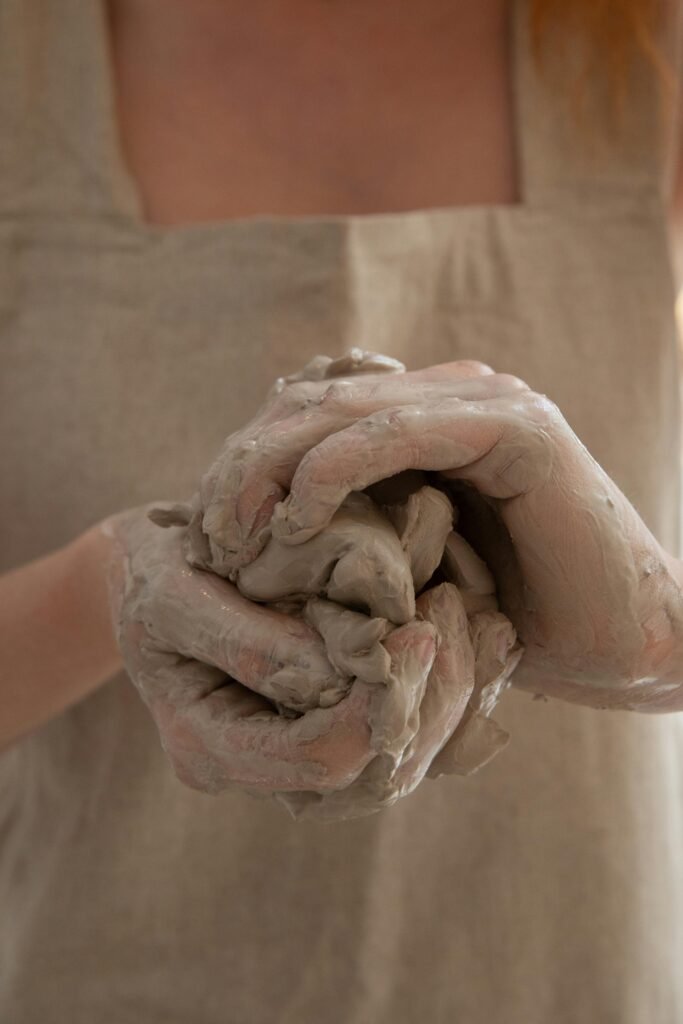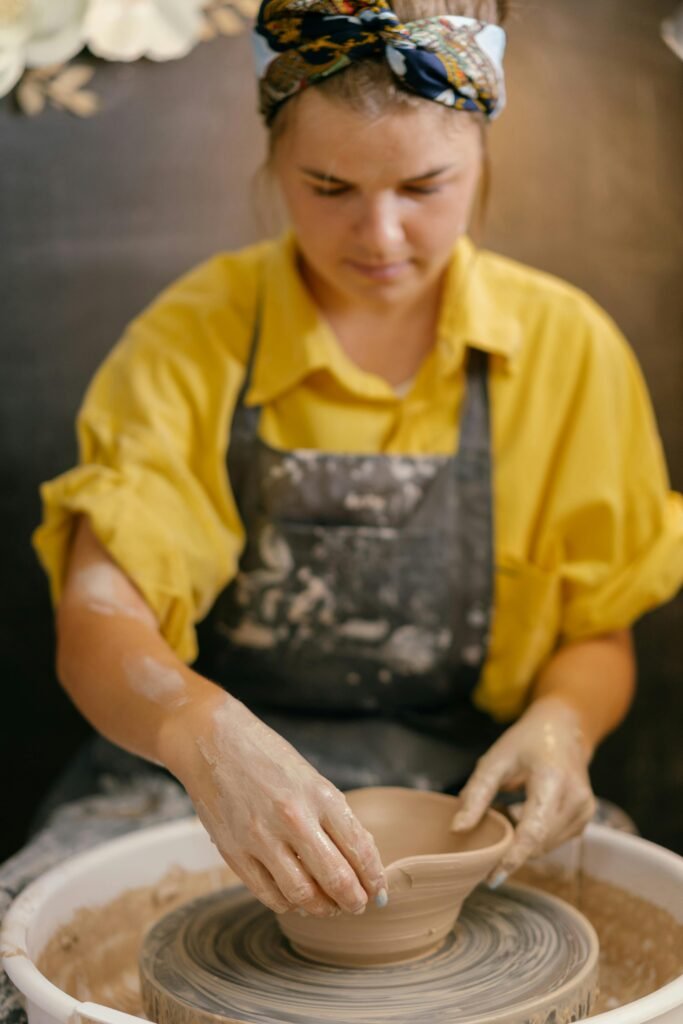Everyone in the family will love doing ceramic projects at home. Getting the proper supplies and tools is the first step in creating ceramics at home, regardless of whether your goal is to pursue pottery as a hobby or a career.
There are some fundamental items you’ll need to buy to begin started, regardless of the kind of products you intend to construct. We’ll list every item you’ll need to start creating pottery at home in this blog .
The most significant one is undoubtedly Clay; you can read more about it below. Using a pottery wheel to assist shape the pieces will undoubtedly simplify the process of creating pottery. Kilns are ovens used to dry clay and shape it into exquisite ceramic objects. Additionally, we’ll provide you with a list of fundamental tools that will enable you to produce pieces that are more accurate, well-formed, and polished. Finally, we will discuss paint, glazing, and the simplest methods for decorating ceramics at home.
1. Clay
All the clay is finely ground soil that, when moist, takes on shape. It has varying amounts of sand, minerals, small rocks, and various organic soil constituents. Depending on the size and makeup of the particles, it comes in a range of textures and hues. High iron oxide concentration clays have a tendency to seem rusty, red, or orange, while low iron clays, such porcelain clay, have a gray or even white appearance.
Clay comes in three varieties: earthenware, porcelain, and stoneware. They all have distinct fire temperatures, water absorption rates, and shrinkage percentages, and they are all utilized for different things.

a. Stoneware clay
Stoneware clay is the most user-friendly and adaptable. For those who are new to the process of creating pottery at home, we suggest starting with stoneware clay. It is available in several hues, ranging from dark brown to white. Because stoneware clay is non-porous after firing, it may retain liquid without the need for glazing.
b. Earthenware
Compared to stoneware, earthenware is typically weaker, heavier, and thicker. It’s also rather simple to work with, however in order to make your pottery permeable, it must be glazed. This additional stage might not be suitable for beginners as it involves more time and materials.
c. Porcelain clay
It is quite challenging to shape porcelain clay, and when shaping it, a significant amount of water must be carefully added to the mixture. It quickly dries out if you don’t add enough water, and it can easily collapse and lose its shape if you add too much. If you want to try making pottery at home for the first time, learning how to work with porcelain clay might not be the ideal option because it takes a lot of time and practice.
Even though porcelain pottery has a lovely appearance, you might want to put it off until you have more skill.
2. Pottery Wheels
Various pottery-making processes are employed by potters and ceramic artists based on the type of products they wish to create. You may certainly produce pottery at home without a pottery wheel, but be aware that your options will be restricted to moldings or shaping everything by hand, which will probably lead to pieces that are uneven and inaccurate in appearance.
We advise getting a pottery wheel if you intend to make pottery at home frequently, especially for any type of rounded ceramic ware like pots, cups, plates, or jugs. With one, you can let your creativity run wild and produce as many pieces as you like, the proper way.
Pottery wheels typically cost between little over $400 and nearly $1,500. Cheap pottery wheels run about $500, such as the Speedball Artista Pottery Wheel. For people who have never made pottery before or want to start at home, similar models are ideal.
However, compared to high-tech professional models, such basic devices are slower, less robust, and have a smaller clay load capacity. Everything is dependent on how much you intend to use it. If you want to purchase a pottery wheel so you may create pottery at home, read our comprehensive article on things to think about when making your purchase.

3. Kilns
Kilns are an oven type that can reach temperatures high enough to fire materials like bricks and pottery; when the clay is shaped, it merely dries and becomes ceramic. Clay must be fired in one manner or another, hence we highly advise you to get a kiln.
Too little heat is produced in kitchen ovens to fire ceramics. Pit fire clay may certainly be made at home, but setting it up and maintaining the precise temperature required for different types of clay are both very challenging. Your clay will melt if it gets too hot, and it won’t dry correctly if it gets too cold.
The temperature will vary depending on whether you are working with porcelain, stoneware, or earthenware. Your needs will determine the range of kiln you need, but an electric kiln is simply adjustable to meet your needs.
You may want to think about factors like the type of glaze you plan to use, the size and quantity of the pieces you will make, and the space you have at home before deciding which kiln to purchase.
4. Tools
While all you really need to start making pottery at home is clay, a pottery wheel, and a kiln, there are a plethora of tools available to assist you in producing more accurate, well-formed, and polished-looking pieces.
The following equipment should be included in your DIY pottery kit:
- Needles: Used to pierce, trim, carve, and measure the thickness of clay.
- Cutter wire: For breaking up big clay blocks into smaller pieces.
- Ribbon tools: Used in hand-shaped clay for trimming and sculpting.
- Scrappers: For the last stage of piece smoothing.
- Fettling Knives: These tools are incredibly useful; apart from carving and sculpting, they may be used to trim, pierce, carve, and even cut large pieces of clay.
- Chamois cloth: For smooth surfaces, squeeze the clay while it’s on the wheel.
- Calipers: A tool for calculating the separation between two opposing sides.
- Brushes: They are useful for many things, but particularly for applying slip or glazing.
- Sponges: Used for surface cleaning and sculpting.
- Additional modeling tools based on the precise components you wish to create.
- Wear aprons and towels since pottery-making at home can become dirty! To keep yourself and your area as tidy as possible, wear an apron and a couple towels.
5. Glaze and other decorating materials
There are many different methods available for decorating ceramics. But, if you’re just starting out with creating pottery at home, we advise you to start with glazes and paints until you gain proficiency with other decorating supplies and more intricate decorating methods like transfer printing or carving.
One of the most popular and straightforward decorating methods is glazing. Glaze is a liquid that gives ceramics a smooth, glass-like surface; it works similarly to paint. It is used to waterproof objects and is available in any color. Additionally, the ideal paints for pottery decorating at home are acrylic or liquid latex paints.
Paints and glazes are inexpensive and readily accessible both online and at almost any art supply store.
How To Start Pottery At Home
Acquiring the necessary tools and equipment is the first step towards beginning pottery-making at home. Everything listed above is readily available on the internet. You can find the clay and all the other components at most art supply stores. We advise you to get clay, a tiny ceramic kiln, a simple pottery wheel, and a few modeling tools if you’re just starting out. As you pick up new methods for creating ceramics at home, you may always upgrade your tools.



